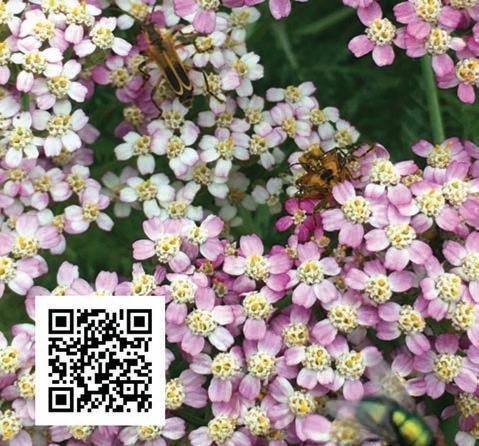
3 minute read
A Thoughtful, Nuanced Approach to Dealing with Garden Pests
by Marta Lynch, Farm Manager, Pennsylvania Horticultural Society
Home vegetable gardens are a Wonderful way to enjoy fresh produce throughout the growing season. However, growers are often challenged by pests that can damage or even destroy their crops.
When we talk about pests in the garden, it is important to remember that our garden is an ecosystem made up of a complex network of biological organisms (plants, animals, fungus,etc.) and their physical environment. The environment and these organisms are constantly interacting and influencing one another to create a delicate and ever-evolving balance of life. When we use pest management methods, we are impacting the balance of this complex network.
Fortunately, there is a system for dealing with pests: Integrated Pest Management. IPM is a science-based approach that takes this whole ecosystem into consideration. It’s not a single method for controlling pests; rather, it’s a decision-making process to incorporate into your gardening. IPM principles include pest identification, monitoring/evaluating, prevention and control.
The Importance of Bug IDs
Most insects in your garden will cause no harm or may even be beneficial. For this reason, it is crucial to learn what pests affect the crops you have and what the damage looks like. “The Organic Gardener's Handbook of Natural Insect and Disease Controls” by Barbara W. Ellis, Fern Marshall Bradley and Deborah L. Martin is a great resource for that. You can work backwards, first looking at the damage and then narrowing down what type of pest might have caused it.
When trying to ID an insect, remember that they go through metamorphosis and can look extremely different at each life stage. Once you have an ID, learn the life cycles and host plants of the pests you have in your garden and region. This knowledge empowers you to make the best management decisions. Common pests in the Philadelphia region include leaf miners (both allium and beet/ spinach), Colorado potato beetles, cabbage white butterflies, cucumber beetles (both striped and spotted), harlequin beetles, tomato horn worms, flea beetles, root maggot flies (both cabbage and onion), squash vine borers, Mexican bean beetles and many more.
The Need to Get a Look-See
Frequent monitoring of insects and evaluation of dam- age in your garden is the building block to a good IPM program. At least once a week, you should be walking through your garden and observing it in detail. What insects are present and what life stage are they in? How many of these insects are you seeing? Where are they located? Do your plants have any physical damage? If so, how much? Evaluate what you are seeing and consider whether you need to do anything.
Seeing a couple pests or a small amount of damage doesn’t mean control methods are needed. For example, if you find a tomato hornworm on your plant, and it has only eaten one branch, consider leaving it to get parasitized by a Braconid wasp, thus supporting the Braconid wasp population in your garden. However, if you find a tomato hornworm has eaten half of your tomato plant, you may want to act.
Worth a Pound of Cure
Prevention is the first line of defense in IPM, and some simple strategies can prevent pest populations from becoming a threat. Strategies and tools used include adding beneficial insect/organism habitat; using pest and/or disease-resistant plant varieties; planting early or late (to offset with pest life cycles); practicing crop rotation, reducing pest habitat by keeping your garden weeded, and cleaning your garden at the end of each season.
The Different Paths to Control
If you have identified your pest(s) and monitored and evaluated damage, but find that preventative controls are no longer effective, consider using a combination of biological, cultural, physical or mechanical and chemical management tools.

Always first choose a control method that has the lowest amount of risk to other organisms and the environment. For example, it’s often a good idea to pull out all your brassicas in July to disrupt the harlequin beetle ‘s life cycle. Physical or mechanical methods, like covering plants with bug netting, will pose the lowest risk.
Biological control involves using natural enemies —predators, parasites and pathogens — to control pests. Examples include green lacewing larvae, ground beetles and minute pirate bugs. ARBICO Organics is a great resource for determining what biologicals can be used to control certain pests.
When all else fails, you can use a chemical control. These can be extremely effective but can also pose a higher risk to other organisms and the environment. It is important to use chemical controls prudently, because pests can become resistant to them if the chemical is overused.
When choosing a chemical control, know if it is a targeted or broad-spectrum chemical. Using organic chemicals doesn’t always mean safety for other organisms. Pyrethrin and copper sulfate are organic chemicals that are extremely effective in killing your targeted pests, but they also kill beneficial insects and pollinators. Welltimed and targeted use can reduce the potential harm to other organisms.
A good IPM program will look different for each garden. Identifying, monitoring and evaluating your garden pests year after year will allow you to learn the rhythm of pest pressure in your garden and make better informed decisions going forward. Don’t be discouraged if you lose crops to a pest — that is more data that will inform future preventative tools and strategies.
By employing IPM principles, you can ensure that you are making more environmentally friendly pest management decisions while ensuring a bountiful harvest from your vegetable garden. Happy growing!








